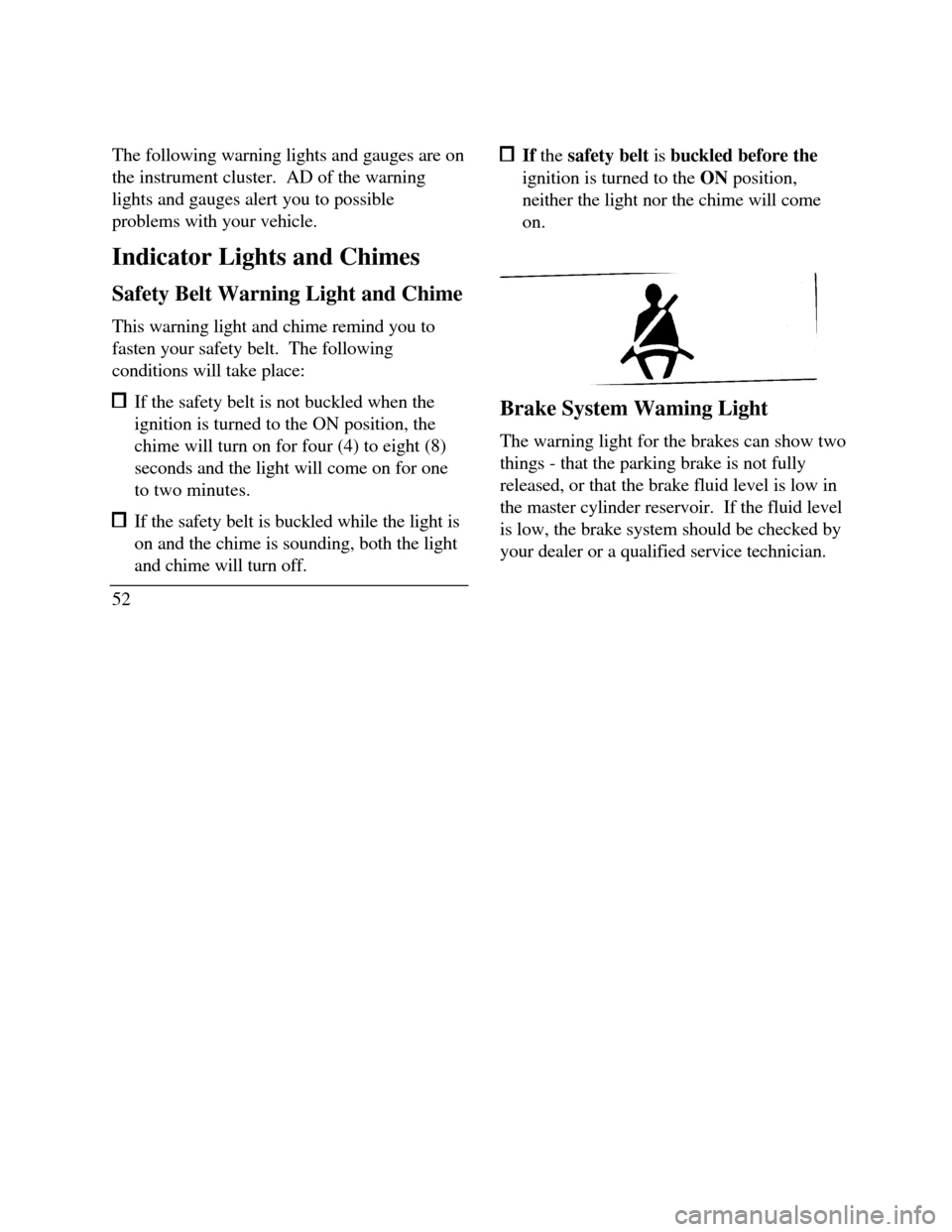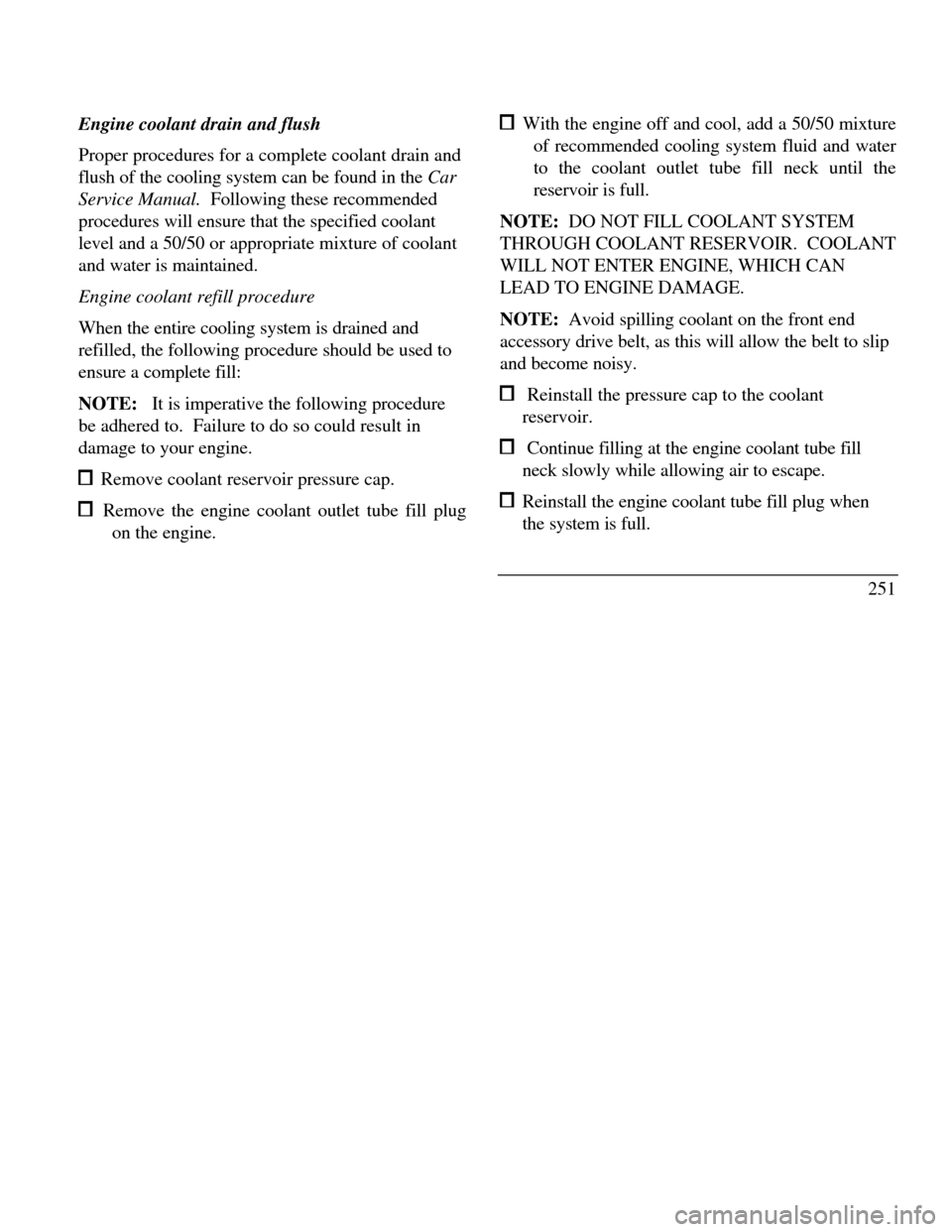Page 46 of 320

/! WARNINGDo not leave children, unreliable adults,or pets alone in your vehicle. They couldaccidentally injure themselves or othersthrough inadvertent operation of thevehicle. Further, on hot, sunny days,temperatures in a closed vehicle couldquickly become high enough to causesevere and possibly fatal injuries to peopleas well as animals.Fuel-Injected Engines
When starting a fuel-injected engine, the most
important thing to remember is to avoid pressing
down on the accelerator before or during starting.
Only use the accelerator when you have problems
getting your vehicle started. See Starting Your Engine
in this chapter for details about when to use the
accelerator while you start your vehicle.Staring Your Vehicle
Preparing to Start Your Vehicle/!\WARNINGDo not start your vehicle in a closed garage orother enclosed area. Never sit in a stoppedvehicle for more than a short period of timewith the engine running. Exhaust fumes aretoxic. See Guarding Against Exhaust Fumesin this chapter for more instructions.Before you start your vehicle, do the following:
1. Make sure you and all your passengers buckle
your safety belts. See Safety Restraints in the
Index for more details.
2. Make sure the headlamps and other accessories
are turned off when starting.
43
Page 55 of 320

The following warning lights and gauges are on
the instrument cluster. AD of the warning
lights and gauges alert you to possible
problems with your vehicle.
Indicator Lights and Chimes
Safety Belt Warning Light and Chime
This warning light and chime remind you to
fasten your safety belt. The following
conditions will take place: If the safety belt is not buckled when the
ignition is turned to the ON position, the
chime will turn on for four (4) to eight (8)
seconds and the light will come on for one
to two minutes. If the safety belt is buckled while the light is
on and the chime is sounding, both the light
and chime will turn off.
52 If the safety belt is buckled before the
ignition is turned to the ON position,
neither the light nor the chime will come
on.Brake System Waming Light
The warning light for the brakes can show two
things - that the parking brake is not fully
released, or that the brake fluid level is low in
the master cylinder reservoir. If the fluid level
is low, the brake system should be checked by
your dealer or a qualified service technician.
Page 63 of 320

The Instrument Cluster
In addition to warning lights, the instrument
cluster has a message center/odometer, a
speedometer, tachometer, fuel and coolant
temperature gauges.
The Electronic Message Center (M/C)
The Electronic Message Center only works
when the ignition is in the ON position.
Each time the WC is powered the display goes
through a self test by displaying the PLEASE
FASTEN SEATBELT message. This self test
is used to stabilize the systems before reporting
the status to you.
60The message center tells you about the
condition of your vehicle by two methods: operator selectable features continuous warning reporting of
monitored systems
You can select different features for the M/C to
display by using the message center control
buttons located to the right of the instrument
cluster. You will hear a tone when you press one
of these buttons. However, if the M/C detects a
warning from any of the monitored systems, then
the M/C will display the appropriate warning
message.
Page 118 of 320
The four-way head restraint
Adjusting the Seats/! WARNINGNever adjust the driver's seat or seatbackwhen the vehicle is moving./!\WARNINGTo reduce the risk of serious injury in acollision, always drive and ride with yourseatback upright and the lap belt snugand low across the hips./!\ WARNINGDo not pile cargo higher than theseatbacks to avoid injuring people in acollision or sudden stop.Using the Power Seats
Your vehicle's power seats can be adjusted in
several directions. You can raise or lower the
whole seat, move the seat forward or backward
and tilt the front and back of the seat up or
down.
115
Page 253 of 320

Engine coolant drain and flush
Proper procedures for a complete coolant drain and
flush of the cooling system can be found in the Car
Service Manual. Following these recommended
procedures will ensure that the specified coolant
level and a 50/50 or appropriate mixture of coolant
and water is maintained.
Engine coolant refill procedure
When the entire cooling system is drained and
refilled, the following procedure should be used to
ensure a complete fill:
NOTE: It is imperative the following procedure
be adhered to. Failure to do so could result in
damage to your engine. Remove coolant reservoir pressure cap. Remove the engine coolant outlet tube fill plug
on the engine. With the engine off and cool, add a 50/50 mixture
of recommended cooling system fluid and water
to the coolant outlet tube fill neck until the
reservoir is full.
NOTE: DO NOT FILL COOLANT SYSTEM
THROUGH COOLANT RESERVOIR. COOLANT
WILL NOT ENTER ENGINE, WHICH CAN
LEAD TO ENGINE DAMAGE.
NOTE: Avoid spilling coolant on the front end
accessory drive belt, as this will allow the belt to slip
and become noisy. Reinstall the pressure cap to the coolant
reservoir. Continue filling at the engine coolant tube fill
neck slowly while allowing air to escape. Reinstall the engine coolant tube fill plug when
the system is full.
251
Page 260 of 320

/!\ WARNINGWhen replacing full size tires, never mixradial, bias-belted, or bias-type tires. Use onlythe tire sizes that are listed on the tirepressure decal. Make sure that all tires arethe same size, speed rating, and load-carryingcapacity. Use only the tire combinationsrecommended on the decal. If you do notfollow these precautions, your vehicle may notdrive properly and safely.Tires that are larger or smaller than your vehicle's
original tires may also affect the accuracy of your
speedometer.
258Information About Tire Quality Grades
New vehicles are fitted with tires that have their Tire
Quality Grade (described below) molded into the
tire's sidewall. These Tire Quality Grades are
determined by standards that the United States
Department of Transportation has set.
Tire Quality Grades apply to new pneumatic tires for
use on passenger cars. They do not apply to deep
tread, winter-type snow tires, space-saver or
temporary use spare tires, tires with nominal rim
diameters of 10 to 12 inches or limited production
tires as defined in Title 49 Code of Federal
Regulations Part 575.104(c)(2).
U.S. Department of Transportation - Tire quality
grades: The U.S. Department of Transportation
requires Ford to give you the following information
about tire grades exactly as the government has
written it.
Page 302 of 320
Brake warning indicator Engine oil pressure light Traction control active light Charging system warning light Fuel gauge ANTI
THEFT active light Service engine soon warning light Engine coolant temperature gauge Safety belt light Turn signal indicator lights High beam light
Air bag readiness light Speedometer Tachometer Anti-theft active light Anti-lock brake warning indicator Message center Odometer304
Page 305 of 320

IndexA Air conditioning, electronic automatic
ABS warning light........................................temperature control system..................71
(see Anti-lock brake system)..................53Air suspension
Accessory position on the ignition............41air leveling disabled warning, message
Accident damage....................................232center................................................62
Additives, engine oil...............................245description.......................................186
Air bag supplemental restraint system...........Alarm, activating remote personal.........106
description...........................................17Alcohol, in fuel.....................................241
disposal...............................................25Antenna, radio
indicator light......................................59(see Electronic sound system)........165
operation.............................................20 Antifreeze (see Engine coolant)......247
proper seating......................................19Anti-lock brake system (ABS).................
tone generator.....................................24description.....................................187
wearing safety belts.............................18noise..............................................187
Air cleaner filter...........................................warning light...................................53
location.............................................237 Anti-theft lug nuts and key...................209
specifications.....................................288
307